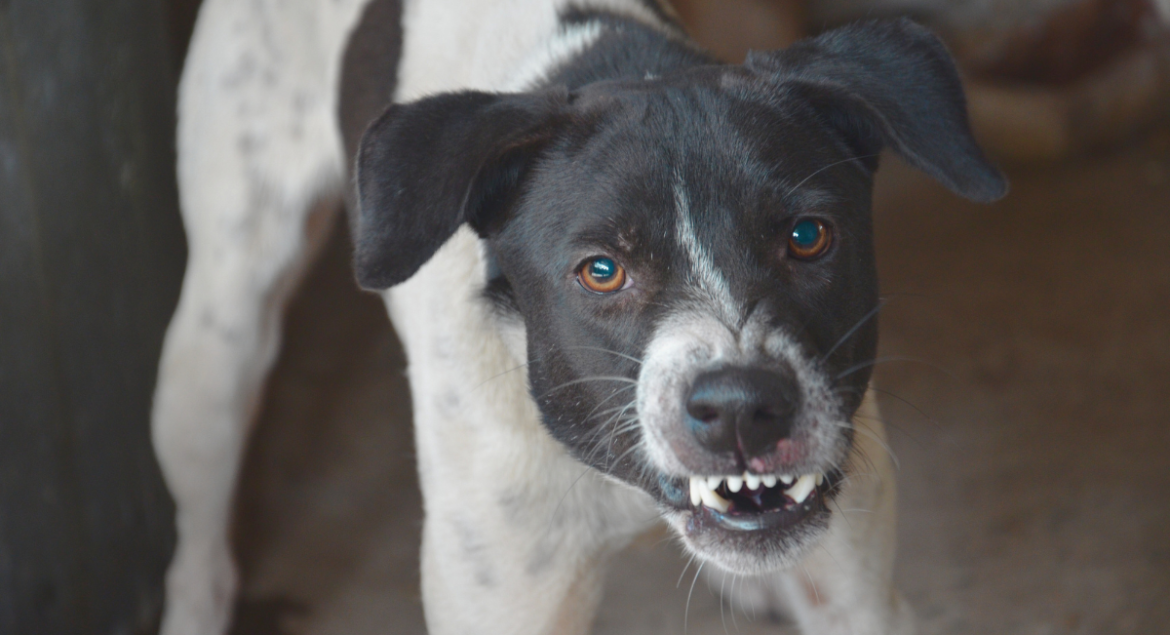
Explore the complexities of aggression in dogs, including fear-based, territorial, and possessive behaviors. Understand the triggers behind aggressive actions and learn effective training methods like positive reinforcement, desensitization, and counter-conditioning. Professional guidance is essential for modifying aggression and ensuring safety for both dogs and their owners. Discover the importance of basic obedience training and the role of socialization in nurturing well-adjusted canine companions. This comprehensive guide will provide dog owners with the knowledge and tools necessary to foster a positive and safe environment for their pets.
Understanding Aggression in Dogs
Aggressive behavior in dogs is a complex issue that manifests in various forms, impacting not only the animals themselves but also their owners and communities. This behavior can be defined as any action by a dog that is intended to assert dominance, instill fear, or protect resources. There are several types of aggression that pet owners should be aware of, including fear-based aggression, territorial aggression, and possessive aggression.
Fear-based aggression occurs when a dog feels threatened and reacts defensively. This type of aggression often stems from past trauma or negative experiences, making it crucial for owners to recognize signs of fear in their pets. Territorial aggression, on the other hand, is exhibited when a dog feels its space is being invaded. This often includes barking, growling, or lunging at intruders. It is essential to differentiate between these feelings, as the response to unfamiliar stimuli may come from a place of both instinct and learned behavior.
Possessive aggression arises when a dog feels the need to protect its belongings, whether it is food, toys, or even its owner. This can be particularly challenging for pet owners, especially if the dog displays aggression towards family members or guests. Psychological factors, including genetics and early socialization experiences, significantly influence the likelihood of a dog developing aggressive tendencies. Physiologically, the presence of stress hormones can further exacerbate aggressive behavior, suggesting that both mental and physical health play crucial roles.
Understanding these types of aggression in dogs is critical for pet owners. Recognizing the early signs not only fosters a safer environment but also allows for early intervention strategies. With effective training and proper socialization, owners can work towards modifying aggressive behaviors and enhancing the well-being of their canine companions.
Identifying Triggers of Aggression
Understanding the triggers of aggression in dogs is a crucial aspect of effective training and behavior modification. Aggression can manifest in various scenarios, and recognizing the underlying causes allows owners to take proactive measures to manage their dog’s behavior. Common triggers may include certain environments, interactions with other animals, and specific human behaviors.
Firstly, environmental triggers play a significant role in a dog’s aggressive responses. For instance, a dog might display aggression when in unfamiliar locations, such as crowded parks or busy streets. These settings can feel overwhelming to a dog, potentially causing anxiety and leading to defensive behaviors. To identify these environmental triggers, owners should observe their dog in different settings, noting any changes in behavior as they enter new environments.
Interactions with other animals are another common source of aggression. Dogs may react aggressively due to fear, protective instincts, or past negative encounters. It is essential for owners to monitor their dog’s body language during these encounters. Signs such as growling, stiffening of the body, or barking can indicate discomfort or aggression. Keeping a safe distance from other animals, particularly if aggression has been a past issue, can aid in recognizing and managing these triggers.
Human interactions can also spark aggressive behavior in dogs. Dogs may become aggressive when they perceive a threat from unfamiliar people or if they are approached too quickly or directly. Observing the dog’s reactions when meeting new individuals can provide valuable insights. Owners should ensure positive introductions—offering treats or praise when dogs respond well to new encounters—and avoid forcing interactions that may provoke fear or aggression.
By diligently observing a dog’s behavior across various contexts, owners can effectively identify aggression triggers. This awareness will promote a better understanding of the dog’s needs, enabling the implementation of tailored training techniques to reduce aggressive behaviors over time.
The Importance of Professional Guidance
When addressing aggressive behavior in dogs, seeking assistance from professional trainers or behaviorists is vital. Aggression can stem from various underlying issues, such as fear, territorial instincts, or lack of socialization. Therefore, professionals equipped with the right knowledge and experience can provide essential insights that are not easily discernible to the average dog owner. They employ scientifically-backed methods that prioritize safety and effectiveness, ensuring positive outcomes tailored to the specific needs of the dog.
One key factor to consider when selecting a professional is their qualifications. Look for certifications from reputable organizations, such as the Association of Professional Dog Trainers or the International Association of Animal Behavior Consultants. These credentials often indicate formal training in canine behavior and positive reinforcement methodologies. A qualified trainer should also possess a thorough understanding of canine body language, allowing them to assess a dog’s emotional state and the context in which aggression occurs.
Another important aspect is the trainer’s approach to aggression management. Professionals should utilize humane techniques that build trust and enhance communication between the owner and the dog. This not only helps in modifying aggressive behavior effectively but also fosters a deeper bond. Furthermore, a tailored training program is paramount. Each dog is unique, and a program that considers breed characteristics, prior experiences, and the specific triggers for aggression is crucial in facilitating meaningful changes.
Ultimately, professional guidance plays an indispensable role in safely managing aggressive behavior in dogs. Not only does it provide dog owners with the tools necessary for effective training, but it also ensures the well-being of both the dog and those surrounding it. By enlisting the support of knowledgeable professionals, owners can navigate the complexities of aggressive behavior with confidence and competence.
Building a Strong Foundation: Basic Obedience Training
Basic obedience training is an essential component in managing dogs with aggressive behavior. By establishing a foundational level of communication between the dog and owner, this training helps create a trusting relationship that is vital for effective behavioral modification. Standard commands such as “sit,” “stay,” “come,” and “down” are not merely tricks; they serve vital roles in fostering safety and control in various situations.
When a dog reliably responds to these commands, it enables the owner to redirect the animal’s focus during moments of potential aggression. For instance, instructing a dog to “sit” can defuse heightened excitement or anxiety, providing the dog with an alternative behavior rather than reacting aggressively. This simple yet transformative technique enhances the owner’s ability to manage their dog’s actions during otherwise volatile interactions.
The process of teaching these commands should start with clear, consistent cues paired with positive reinforcement. Using rewards such as treats or praise when the dog follows a command encourages desired behaviors, making training a mutually enjoyable experience. This method not only helps to solidify the dog’s learning but also promotes a positive association with the commands being practiced.
Furthermore, establishing a routine in practicing basic commands allows for the reinforcement of good behavior in various contexts. Incorporating training into daily activities, such as during walks or playtime, helps to maintain the dog’s obedience amidst distractions. This ongoing training supports a well-adjusted dog that can better handle stressors that may lead to aggression.
Ultimately, strong obedience skills lay the groundwork for more advanced training and behavior modification techniques. Engaging in consistent basic obedience training should be a priority for dog owners, especially those dealing with aggressive behaviors, paving the way for improved interaction and safety in everyday situations.
Positive Reinforcement Techniques
Positive reinforcement is an effective training method that significantly contributes to modifying aggressive behavior in dogs. This approach involves rewarding desirable behaviors, which encourages the dog to repeat these behaviors in the future. The fundamental principle behind positive reinforcement is to strengthen the association between a specific action and a positive outcome, thereby creating a more desirable behavioral pattern.
To successfully implement positive reinforcement, it is crucial to identify what motivates each individual dog. Rewards can take various forms, including verbal praise, treats, toys, or playtime. For instance, if a dog exhibits calm behavior in the presence of a trigger, such as another dog, providing a high-value treat immediately reinforces that behavior. Timing is essential; rewards should be given promptly to create a clear connection between the behavior and its positive consequence. A delay in rewarding can lead to confusion, making it vital to stay vigilant during training sessions.
Consistency plays a pivotal role when using positive reinforcement techniques. All family members should use the same commands and rewards to avoid confusing the dog. For example, if a dog is trained to sit using the command “sit” and rewarded with a treat, a family member should not use a different command or reward. Establishing a consistent routine aids the dog in understanding expectations and reinforces good behavior more effectively.
While utilizing these techniques, it is crucial to remain patient and avoid punitive measures which can exacerbate aggressive tendencies. Instead, focus on gradual exposure to scenarios that trigger aggression, rewarding the dog for displaying calmness. Over time, this structured approach fosters a more positive association with the previously anxiety-inducing stimuli, leading to a significant reduction in aggressive behavior.
Desensitization and Counter-Conditioning
Desensitization and counter-conditioning are effective techniques used to modify aggressive behavior in dogs. These methods focus on changing the dog’s emotional response to specific triggers, allowing them to react more positively over time. The overarching goal is to reduce the intensity of the dog’s aggression by gradually exposing them to anxiety-provoking stimuli in a controlled way.
Desensitization begins with identifying the specific triggers that provoke aggressive responses in the dog, such as other dogs, strangers, or loud noises. Once the triggers are identified, the exposure to these stimuli should be carried out at a distance or in a manner that does not overwhelm the animal. For example, if a dog reacts aggressively to other dogs, it may be beneficial to allow the dog to observe another dog from a safe distance where they feel comfortable. The key is to ensure that the dog remains calm throughout this exposure, which can help reduce the level of anxiety associated with the trigger.
Counter-conditioning complements desensitization by aiming to change the dog’s emotional response to the same stimuli. This process involves creating positive associations with the triggers. For instance, when the dog sees another dog, treats can be offered to promote a positive reaction instead of aggression. Over time, the dog learns to associate the once-feared stimulus with positive experiences, leading to reduced aggressive behaviors. Consistency is crucial throughout both processes. Regular training sessions that incorporate both desensitization and counter-conditioning should be conducted in controlled environments until the desired response is achieved.
Incorporating these methods into a broader training program is essential for effectively diminishing aggressive tendencies. With patience and perseverance, many dogs can learn to manage their reactions and develop healthier coping mechanisms in response to previously stressful situations.
Creating a Safe and Structured Environment
Managing aggressive behavior in dogs requires a well-planned approach, beginning with the establishment of a safe and structured environment. A calm space not only assists in reducing stress for the dog but also facilitates their training. One of the first steps is to define and establish clear boundaries within the home. This entails determining which areas are accessible to the dog and ensuring they understand the limitations of their space. By maintaining consistency in these boundaries, dogs are more likely to feel secure and less anxious, thereby minimizing aggressive tendencies.
Utilizing crates can also play a significant role in creating a safe environment. Crate training can serve as a valuable tool in providing dogs with a personal sanctuary where they can retreat and feel protected. It is essential to introduce the crate positively, making it a comfortable and inviting place by using soft bedding and toys. Ensuring that the dog sees the crate as a safe haven can allow them to decompress when stress levels rise. Moreover, when managed effectively, crate training assists owners in monitoring their dog’s behavior and preventing situations that could trigger aggression.
In addition to boundaries and crate training, fostering a calm atmosphere at home is crucial. This can be accomplished by minimizing loud noises and chaotic activities that could exacerbate a dog’s aggression. Maintaining a quiet environment and engaging in positive reinforcement techniques contribute to a feeling of security for the dog. Incorporating regular routines, such as scheduled feeding and exercise, can also assist in establishing a sense of normalcy and predictability. By focusing on these elements, owners can significantly reduce stress for their dogs, which in turn may lead to improved behavior and a more harmonious living situation.
Socialization Strategies for Aggressive Dogs
Socialization plays a critical role in managing and mitigating aggressive behavior in dogs. Early and ongoing exposure to diverse people, animals, and various environments can significantly reduce the likelihood of aggression. Proper socialization helps dogs develop healthy coping mechanisms, enhances their confidence, and fosters positive interactions with others. The key to effective socialization for aggressive dogs is to create controlled, positive experiences that promote comfort and security.
One effective strategy involves gradually introducing the dog to different stimuli in their environment. Start with low-stress situations, such as brief encounters with calm, well-behaved dogs or friendly individuals. Slowly increase the exposure over time as the dog shows readiness to engage. This gradual approach minimizes overwhelming experiences and allows for positive associations to be formed. Ensure to reward your dog with treats and praise during and after these interactions to reinforce good behavior.
Additionally, enrolling the aggressive dog in professional training classes can be an invaluable resource. These classes usually provide a structured environment with experienced trainers who understand canine behavior. They also allow the dog to socialize with other dogs under supervision, enhancing their comfort level and exposing them to positive interactions. Another useful technique is arranging playdates with stable, friendly dogs that have a calm demeanor and can help teach appropriate behaviors through social cues.
It is crucial to monitor the dog’s body language throughout these interactions. Signs of stress or discomfort, such as cowering, growling, or stiff postures, should be addressed immediately. Implementing timeouts or removing the dog from the situation can provide relief and prevent escalation. Over time, with patience and consistent efforts in socialization, aggressive dogs can learn to navigate their environment more confidently and reduce their aggressive tendencies.
Monitoring Progress and Adjusting Training Methods
Monitoring the progress of a dog with aggressive behavior is vital in the training process, as it allows pet owners and trainers to assess the effectiveness of their methods. Regular evaluation helps identify improvements and setbacks, ensuring that the training remains relevant to the dog’s evolving needs. One effective way to monitor a dog’s behavior is to maintain a detailed training journal, where observations can be documented over time. This journal can include notes on specific behaviors exhibited during training sessions, reactions to various triggers, and general demeanor in different environments.
It is essential to remain vigilant for signs of progress in the dog’s behavior, such as decreased aggression during encounters with other dogs or people. Positive behavioral changes, like a calmer response to stimuli that previously triggered aggressive responses, indicate that training techniques are effective. Conversely, if a dog’s aggressive behavior intensifies, it may signal the need for adjustments in the training approach. Recognizing these patterns allows owners to implement timely modifications, ensuring the training is responsive to the dog’s development.
Flexibility in training methods is crucial for addressing the unique needs of each dog. Techniques that work for one dog may not prove effective for another, and the dog’s temperament, past experiences, and individual personality should always be taken into account. It may be beneficial to explore various training methodologies, such as positive reinforcement, desensitization, and counter-conditioning, adjusting the emphasis based on progress observed. Regular assessments and the willingness to alter training strategies as necessary can enhance the overall effectiveness of managing aggressive behavior in dogs.



